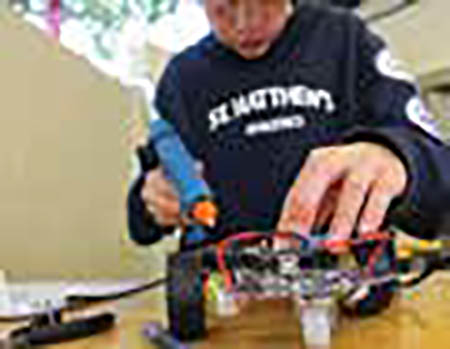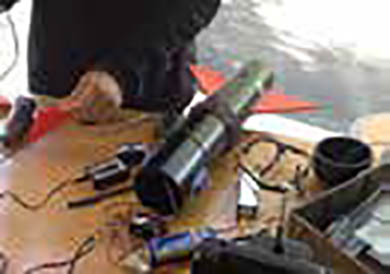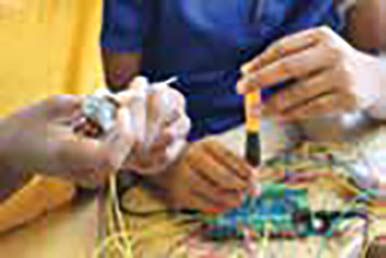Coding, Making, 3D Printing, and Learning

PIRL space in use during Creator’s Studio To give students the opportunity to stretch their creative ideas and manifest them in the physical world, they need the appropriate space, tools, time, and support at their schools. St. Matthew’s Parish School in Pacific Palisades, CA, has created what they believe to be the necessary environment to foster this creativity
SPACES AND TOOLS
St. Matthew’s Parish School has two dedicated spaces where tools are most readily accessible. The first space is the Project & Idea Realization Lab (PIRL), which is described as the clean work space. It is outfitted with the following tools and materials:
■ Four 3D printers
■ Various Arduino microcontrollers and Raspberry Pi
■ Hummingbird robotics kits
■ Soldering irons, and other electronics tools
Tools and ideas to transform education. Sign up below.
■ Spare parts, including motors, switches,
LEDs, resistors, toy wheels, and fans The PIRL space is designed to facilitate the kind of learning environment that allows for creativity, flexibility, and collaboration. The tables can quickly be configured to accommodate pairs, small groups, and large groups. They also fold up, roll, and nest into each other when not used. Most of the walls are writable surfaces, one with a SMART interactive projector that makes it a touch surface as well. Electrical pull-downs are placed in the ceiling for easy access to power anywhere in the room. A giant wall for storage, a green screen filming area, and two audio recording studios complete this indoor space. Just outside, accessible through a roll-up garage-style door, is an additional work area for students that also includes a large wall with writable surface.
The second learning space is the PIRL Terrace. The Terrace is considered the messy space, which includes the following tools and materials:
■ Laser cutter
■ Desktop CNC
■ Miter saws
■ Drill press
■ Handheld power tools
PIRL Terrace tools and materials ■ Wood, acrylic, cardboard, pegboards, and other materials for students to use in building their projects
Students maneuver between these two spaces when working on larger projects. One person in a group might need to design a part in 3D, while another needs to measure and cut a piece of wood. Student work depends on the goals of the project and the direction that students choose to take in their design and construction. The two learning spaces complement each other. They also work in sync with the art room and science lab.

TIME AND SUPPORT
While providing the space and tools is integral for deep project exploration, the process only works due to an allowance for flexible time and the support of trained personnel. The school’s technology staff is trained in the use of the various tools in PIRL and PIRL Terrace. They have also built flexibility into student schedules so that trained personnel can provide in-class support for other faculty when using the spaces.
PROJECTS AND PROGRAMS
By using the mantra “If you build it, they will come,” from the film Field of Dreams, the school has had great success in getting the spaces used by various grade levels, core content areas, and programs. In addition, the school has designed programs specifically for work in PIRL. These examples include the following:
Student works on car chassis with Arduino, motor shield, and programmed IR remote. • Creator’s Studio: This 7th- and 8th- grade elective course focuses on individual, student-driven projects. The course begins with a basic introduction to four major concepts: circuits, coding, physical computing, and 2D and 3D digital fabrication. As a whole group, students explore these concepts together through short projects at the beginning of the semester. Once students have mastered the basics, they can begin working on in-depth individual projects. Students are required to post project reflections on their own blogs. Personal projects have ranged from remote-controlled boats to motion-sensing nerf shooters to 3D-printed tools. Students invariably build in a combination of elements (e.g., circuits, coding, and digital fabrication) in order to accomplish the goals of a project. However, as in the case of the Bouncy Shoes project, it may take just a miter saw, a drill, wood, screws, and rubber bands to build the project. Most importantly, all projects go through multiple iterations as students evaluate and redesign along the way. More information about Creator’s Studio and student blogs can be seen at http://creatorsstudio.org/

Students design and 3D print fins necessary for submarine navigation. • D.E.E.P.: About half of the 8th-grade class participates in the Diving Educational Enrichment Program (D.E.E.P). This third-trimester unit integrates STEAM concepts with underwater diving in order to explore and test laws such as Boyle’s Law, Charles’s Law, Henry’s Law, and the concepts of buoyancy and pressure. For students who opt to design and build underwater submarines as part of their experiment, access to 3D design and printing is essential for the creation of unique parts with custom measurements. Students might design fins or propellers in TinkerCAD and then print them out at their desired size. The ability to quickly create a prototype is essential so that students can test out parts and return to the design phase if they run into problems.

Students design Chinese characters by hand, live trace them in Illustrator, and laser cut on wood. • Ancient Chinese Inventions: In 8thgrade history class, students studying ancient Chinese inventions are given the opportunity to build a replica of their choice. Projects have ranged from a life-sized, two-sided axe, to a crossbow with working trigger mechanism, to working woodcut stamps. Students use Illustrator to design pieces and laser cut their parts in wood. They might also choose to design in 3D using TinkerCAD or 123D Design and print out the final product in plastic.

Students working on a distance-sensing robot using a Hummingbird kit. • Summer STEAM Institute: During the summer, St. Matthew’s offers a week-long STEAM institute for the Boys and Girls Club of Venice and the Neighborhood Youth Association. The theme for the week is “Breaking the Code.” Students can explore The Code of Language by discovering Shakespeare, The Code of Life by exploring DNA, and The Code of the Computer by learning programming. One aspect of this week is to design an interactive display of some kind, using a Hummingbird robotics kit and recycled materials. Students learn to program their Hummingbird board using Create Labs Visual Programmer, which allows them to sense the environment through distance measurement, ambient light, sound, and temperature. In reaction to changes in the environment, LEDs can light up and blink and motors can rotate. Students build around this robotic platform, using wood, cardboard, and an assortment of recycled and repurposed materials.

WORD IS SPREADING
St. Matthew’s Parish School believes that the maker movement is more than just a movement, particularly in education. The work of their students represents a true shift to a more hands-on, real-world, authentic form of learning. The school has built more opportunities for coding in the lower grades and offers an after-school class for young makers. This spring, they plan to start a new club with a focus on 3D design and printing, along with building drones. At St. Matthew’s, they built it, and they have indeed come.
John Umekubo is the director of technology at St. Matthew’s Parish School in Pacific Palisades, CA.
To learn more about St. Matthew’s Parish School, visit
School Web site:
http://www.stmatthewsschool.com/
Creator’s Studio:
http://creatorsstudio.org/
Lucas Scholars Program:
TOOLS THEY USE
► Arduino, Flora, and Trinket microcontrollers
► Cricut Explore paper and vinyl cutter
► Cube 2 3D printer
► Full Spectrum 5th-generation hobby laser cutter
► Hummingbird robotics kits
► Makerbot Replicator, 5thgeneration
► Mojo 3D printer, Stratasys
► Othermill desktop CNC
► Raspberry Pi
► Sparkfun Digital Sandbox
